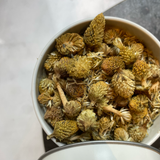Brède Mafana Flower
Description
Brède Mafana flower
Acmella OleraceaNet volumes and weights: 50ml / 7g / 0.25oz
Origin: Madagascar
The term brède Mafana comes from Creole and Malagasy, the adjective bredy comes from Malagasy which means “grass” and mafana which means “hot”. The terminal caitules are conical and yellow or red in color.
The leaves and flower buds have a pungent peppery flavor that is strongest in the open yellow flowers. The flowers especially are slightly anesthetic: the effect produced is very special.
In Morondava, the name kimalao is reminiscent of the spiciness of peppers, because malao means "what stings and heats" at the same time.
The brèdes mafanes are not only consumed by Malagasy, Mahorais, Comorians, Reunionese and South Americans. They have been adopted throughout Southeast Asia. They are commonly found in Chinese and Vietnamese grocery stores because they can replace nuoc-mâm, which has a strong smell of fermented fish.
The leaves can be used fresh or dried. Whole leaves (and flowers, depending on taste) are used as the basis of the Malagasy national dish “romaza” (sometimes called, in Europe, roumazaf). This dish is also very common in the Comoros Archipelago. The plant is reputed to be anesthetic, diuretic, digestive, sialagogue, antiasthmatic and antiscorbutic. Its flower heads are reputed to be odontalgic and antiscorbutic.
Usage tips
Mafanes brèdes are also used, under their Portuguese name of jambu, in the typical cuisine of the State of Para, in the Brazilian Amazon: duck with tucupi (cassava juice), tacaca, cariru.
Traditionally used with meats, red and white such as beef or duck, but they will also go well with fish. They will flavor vegetable casseroles, dishes in sauce, rice or as a simple side dish. They will spice up your salads, dressings and marinades. They will be very suitable in your hot or cold drinks, infusions, teas, herbal teas.




